Aggborough Stadium: Kidderminster Harriers
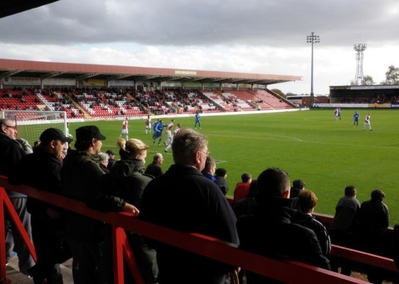
Roger Cornfoot - Aggborough Stadium, Kidderminster
With room for about 7,000 people, Aggborough is a decently sized stadium for a team ploughing its furrow in the National League. It is also one of the oldest, having opened its doors for the first time in 1890 when a single grandstand stood on the touchline. As you can imagine, numerous changes have been implemented since then, up to and including the fact that it was shared with Worcester City for a time. Its location in the Midlands means that Wolverhampton Wanderers use the stadium in order to get their Under-23s playing in a relatively impressive location for their home matches when they can.
There was a highly successful athletics and rugby union club that existed in Kidderminster in the 19th century, but they were both wound-up in 1877. Three years later and the athletics club combined forces with a local rugby club in order to form the Kidderminster Harriers and Football Club. They played their games until the end of the 1885-1886 season, at which point rugby was abandoned and the club began to play under Football Association rules. As a result, it is felt that the Kidderminster Harriers that exists today has existed since 1886, with the period of time when it played rugby being effectively scrubbed from the record books.
Stats
| Aggborough Stadium Stats | |
|---|---|
| Year Opened | 1884 |
| Capacity | 6444 |
| Average Attendance | 1802 |
| Record Attendance | 9155 ( Kidderminster v Hereford (27/11/1948)) |
| Pitch Size | 107 x 69 (7383) |
| Nickname | Aggy |
| Owner | Kidderminster Harriers |
| Clubs Hosted | Kidderminster Harriers, Worcester City, Wolverhampton Wanderers U23s |
| Kidderminster Harriers Stats | |
|---|---|
| Year Founded | 1886 |
| Nickname | Kiddy, Harriers, Carpetmen, The Reds |
| Club Mascot | Harry the Harriet |
| Rivals | Stourbridge, Hereford, Bromsgrove Sporting , Worcester City |
| Previous Stadiums | White Wickets, Chester Road |
| Kit | Red (Home) / Black and Blue (Away) |
| Training Ground | Stourbridge College Centre of Sporting Excellence |
| Shirt Sponsor | Adam Hewitt Limited |
| Team Owner | Richard Lane |
| Record Goalscorer | Peter Wassall (448) |
| Record Appearances | Brendan Wassall (686) |
Aggborough Stadium Photos
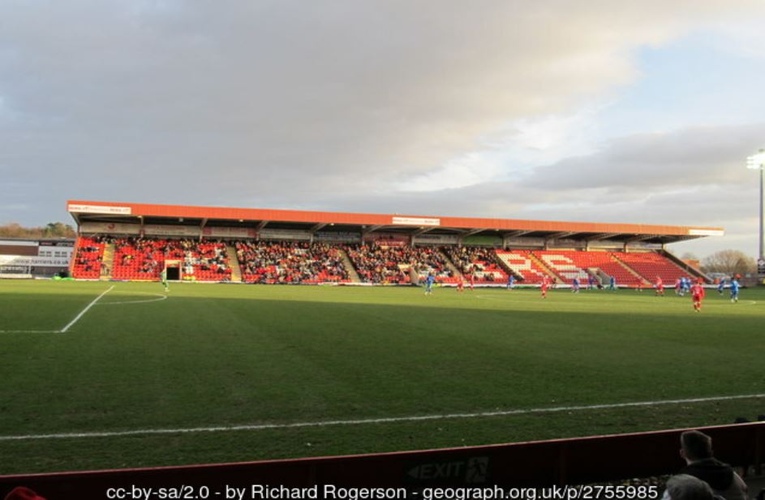
The East Stand at Aggborough Stadium
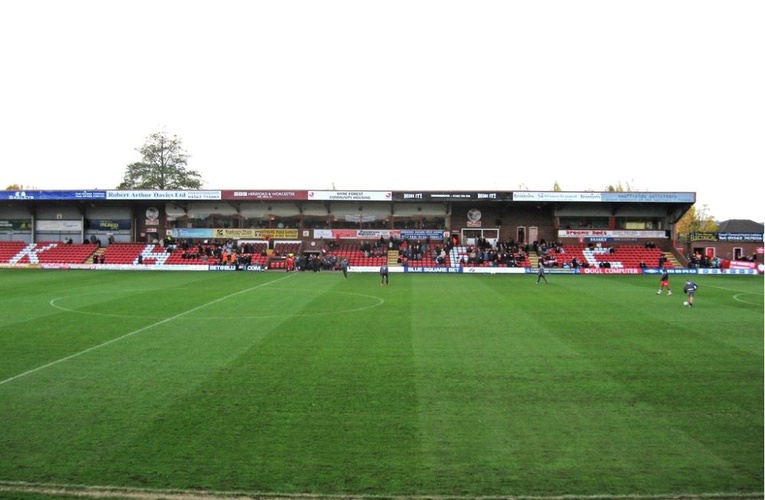
Aggborough Stadium West Stand
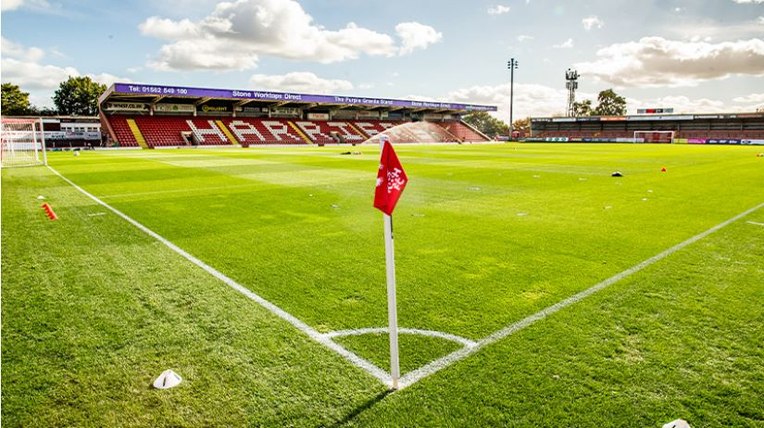
From Kidderminster Harriers / Credit: Craig Anthony
Aggborough Stadium Seating Plan and Where to Sit
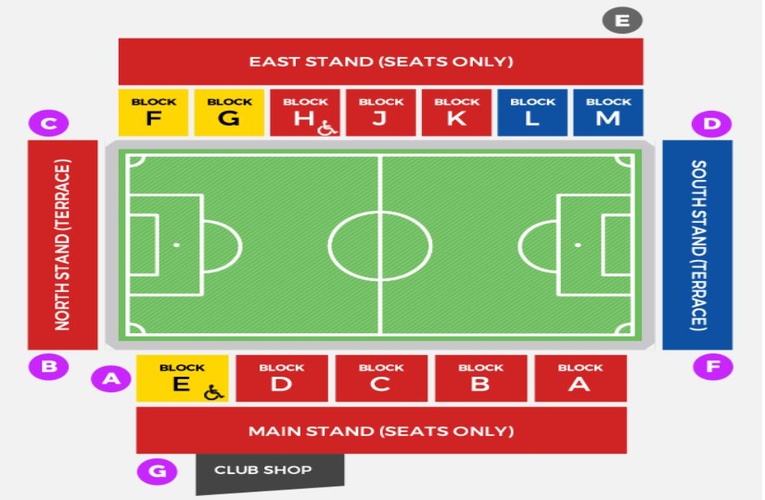
There are four stands at Aggborough Stadium, with the North and South Stands being behind the goals. The South Stand is where the away fans that want to stand up are located, whilst the most vociferous home fans stand by the goal in the North Stand. The Main Stand is where home fans who are seated will be found, running along the side of the pitch on the west side of the stadium. The Purple Granite Stand, meanwhile, runs along the pitch on the east side of the ground and is where away fans will be if they want to sit down.
Kidderminster Harriers Ticket Prices
Kidderminster Harriers make things somewhat complicated when it comes to the ticket prices. Aside from the fact that you’ll be charged an extra fiver if you buy your tickets in person on the day of the game, you have to pay more depending on where you want to be and what your personal circumstances are. Here is a table looking at the prices for the 2023-2024 season so you’ll get a sense of what we’re talking about:
| Stand | Adult Price | Over 65 Price | Student / Young Adult Price | Under 16 Price |
|---|---|---|---|---|
| North Terrace (Standing) | £18 | £14 | £12 | £5 |
| EBC Group Main Stand (Seated) | £20 | £16 | £14 | £6 |
| Purple Granite Stand (Seated) | £20 | £16 | £14 | £6 |
| Away Standing in the South Stand | £18 | £14 | £12 | £5 |
| Away Seated in the Purple Granite Stand | £20 | £16 | £14 | £6 |
In essence, if you want to have a sit down then you’re going to end up paying more for the privilege.
How To Get Kidderminster Harriers Tickets
Getting tickets for Kidderminster Harriers is easy enough online. In fact, that is how the club would prefer for you to do it, considering they charge an extra £5 for anyone buying from the box office on the day of the match.
Where to Buy
Getting To Aggborough Stadium
Train – Kidderminster Train Station is found about half a mile from Aggborough Stadium. That means it’s walkable for those that are able and willing to do so. Of course, Kidderminster itself is only 17 miles from Wolverhampton and 19 miles from Birmingham, so getting a train to either of those places might make life easier for you.
Bus – The 303 stops pretty much right outside the stadium, so if you’re hoping to get the bus there then that is the one to aim for.
Car – If you’re planning on driving to Aggborough Stadium then you’ll want to exit the M5 onto the A456 and follow the signs for Kidderminster, should you be coming from Birmingham or Wolverhampton. If you’re heading in from Worcester then take junction six for the A449, whilst those coming from the south-wast will take the M40 and M42 to get to the M5.
By Air – Birmingham International Airport is around 30 miles for Kidderminster, so if you’re going to fly in to watch the Harriers then that is where you’ll be flying to. The train links are quite good from there.
Taxi – It will cost you somewhere in the region of £10 to get a taxi from Kidderminster Railway Station to the football ground, with that price going up or down depending on how heavy the traffic is.
Parking Near Aggborough Stadium
Parking at Aggborough Stadium is limited, with a council car park existing by the North Stand and charging £7.50. It is a residential area, so you might be able to find on-street parking but make sure to obey all of the rules of the road.
Useful Resources
- Parking - Just Park
Pubs and Bars Near Aggborough Stadium
The Harriers Arms
King and Castle
Pennies
About Kidderminster Harriers
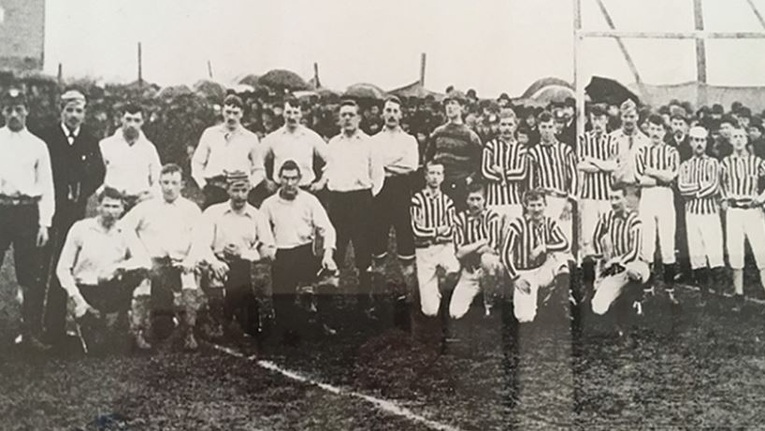
Formed in 1886 when the rugby club decided to switch its allegiance to Football Association rules, Kidderminster Harriers played their games at Chester Road initially. The first ever match took place on the 18th of September when they won 2-1 at Wilden. A rival team called Kidderminster Olympic formed in 1887 and the two clubs helped to form the Birmingham and District League two years later. The clubs amalgamated in 1890 and simply became Kidderminster Football Club. Life was tough in the Football League, so the club resigned from it and wound up in 1891, reverting to amateur status and becoming Kidderminster Harriers.
As you might imagine for a club with a long history, there have been many ups and downs during the existence of Kidderminster Harriers. They made it into the Football Conference in 1983, for example, and won it in 1994, only to be refused entry into the Football League. They club has enjoyed some relative success in the FA Cup over the years, reaching the Fifth Round in 1994. Compared to Premier League sides, their successes have been minor, but in lower league terms they’ve had some celebrated moments. They won the FA Trophy in 1986-1987, the Conference League Cup a decade later and numerous other titles throughout the club’s history.
Aggborough Stadium History
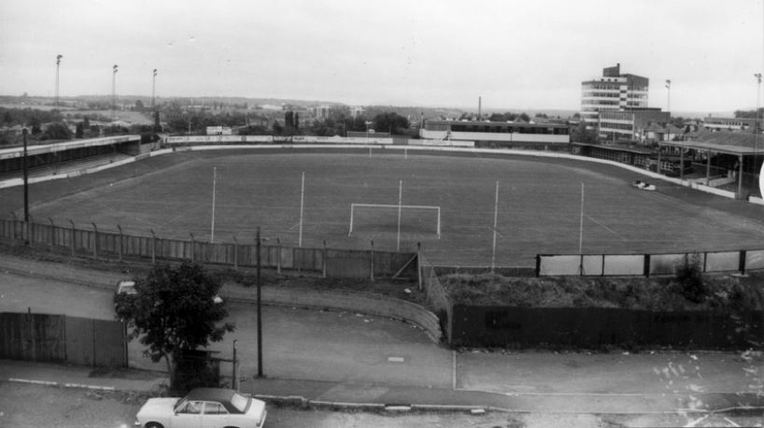
In spite of the age of Aggborough, which opened its doors for the first time in 1884, there isn’t a huge amount to tell you about it. That is because it hasn’t changed a huge amount since then, with the obviously exception of numerous different modernisations. When it opened it had just one grandstand and there was a banked running track that ran around the outside of the pitch. It wasn’t until 1935 that a new grandstand was built, with covered areas being added between then and the outbreak of the Second World War. The running track got replaced by a cycling track after the War, whilst a new East Stand was built in 1979.
The fact that not much happened between the end of the Second World War and 1979 probably tells you what you need to know about the venue. Terracing was created around the pitch four years later, whilst the cycling track got removed and a new Main Stand was built in 1994. Part of the problem for Kidderminster Harriers has been that the ground hasn’t met Football League standards, which is why the club wasn’t promoted when it won the Football Conference for the first time in 1994. Improvements were made so that that wasn’t the case the next time they won it, with a new East Stand opening in 2003.
